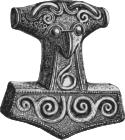- Dráp Niflunga
-
 Attila the Hun (Atli) gets his revenge by killing the lords of the Burgundians in this section of the Poetic Edda.
Attila the Hun (Atli) gets his revenge by killing the lords of the Burgundians in this section of the Poetic Edda.
The Dráp Niflunga is a short prose section in the Poetic Edda between Helreið Brynhildar and Guðrúnarkviða II. Henry Adams Bellows notes in his commentary that the purpose of the section is to serve as a narrative link between the poems.
In the preceding sections, both Sigurd and Brynhildr have died and this section deals with how Brynhild's brother Atli becomes Gudrun's second husband and with how Atli avenges Brynhild's death by slaying Gudrun's brothers Gunnar and Hogni.
Storyline
This is Henry Adams Bellows' translation of the section:
“ Gunnar and Hogni then took all the gold that Fafnir had had. There was strife between the Gjukungs and Atli, for he held the Gjukungs guilty of Brynhild's death. It was agreed that they should give him Guthrun as wife, and they gave her a draught of forgetfulness to drink[1] before she would consent to be wedded to Atli. The sons of Atli were Erp and Eitil, and Svanhild[2] was the daughter of Sigurth and Guthrun. King Atli invited Gunnar and Hogni to come to him, and sent as messenger Vingi or Knefröth.[3] Guthrun was aware of treachery, and sent with him a message in runes that they should not come, and as a token she sent to Hogni the ring Andvaranaut and tied a wolf's hair in it.[4] Gunnar had sought Oddrun,[5] Atli's sister, for his wife, but had her not; then he married Glaumvor,[6] and Hogni's wife was Kostbera;[7] their sons were Solar and Snævar and Gjuki.[8] And when the Gjukungs came to Atli, then Guthrun be sought her sons to plead for the lives of both the Gjukungs, but they would not do it.[9] Hogni's heart was cut out, and Gunnar was cast into the serpent's den. He smote on the harp and put the serpents to sleep, but an adder stung him in the liver.[10] ” Notes
- ^ According to the Völsunga saga, it was Gudrun's mother Grimhild who gave her the drink, just like she gave Brynhildr a draught of forgetfulness to forget Sigurd.
- ^ Svanhild was Ermanaric's queen and Bellows suggests that Svanhild was incorporated with this tradition in order to link the two legends.
- ^ Atlakviða calls the messenger Knéfröð, whereas Atlamál says that there were two messengers but only mentions Vingi. Bellows suggests that the author of the prose section unsuccessfully has combined the two accounts.
- ^ Bellows suggests that this is another instance of the annotator combining two accounts: in Atlakviða Gudrun sends another ring (not Andvarinaut) with a wolf's hair, and in Atlamál, she sends a message in runes, but the messenger falsifies the message and when Högni's wife Kostbera receives it, she is only able to suspect danger.
- ^ Oddrún, who is the sister of Atli and Brynhildr, is according to Bellows mainly known through the Oddrúnargrátr. He suggests that she is a late addition to the Scandinavian version of the Nibelung tradition, because she only appears as Gunnar's lover.
- ^ Bellows states that very little is known about Glaumvar, although she figures frequently in Atlamál.
- ^ According to Bellows, Bera, or Kostbera, is only known for being skilled in runes, and for having a brother named Orkning.
- ^ Bellows notes that Sólarr and Snævarr are mentioned as Högni's and Kostbera's sons in Atlamál, and he suggests that Gjúki, who is named after his grand-father, is the annotator's addition.
- ^ Later Gudrun would kill her and Atli's sons Erpr and Eitil in revenge, and Bellows suggests that the part on her asking Erpr and Eitil to intervene on Gunnar and Hogni's behalf is an addition by the editor of the Poetic Edda in order to give Gudrun an additional reason for killing her own sons.
- ^ In Oddrúnargrátr, it was Atli's mother who transformed herself into an adder in order to make her son's vengeance complete.
References
- The Slaying of The Niflungs Henry Adams Bellows' translation and commentary
- The Slaughter of the Niflungs Benjamin Thorpe's translation
- The Fall of the Niflungs Lee M. Hollander's translation
- Dráp Niflunga Sophus Bugge's edition of the manuscript text
- Dráp Niflunga Guðni Jónsson's edition with normalized spelling
Norse paganism Deities,
heroes,
and figuresOthersAsk and Embla · Dís (Norns · Valkyries) · Dwarf · Einherjar · Elves (Light elves · Dark elves) · Fenrir · Hel · Jörmungandr · Jötunn · Sigurd · Völundr · Vættir
Locations Asgard · Bifröst · Fólkvangr · Ginnungagap · Hel · Jötunheimr · Midgard · Múspellsheimr · Niflheim · Valhalla · Vígríðr · Wells (Mímisbrunnr · Hvergelmir · Urðarbrunnr) · YggdrasilEvents Sources Society See also The Poetic Edda Mythological poems Völuspá · Hávamál · Vafþrúðnismál · Grímnismál · Skírnismál · Hárbarðsljóð · Hymiskviða · Lokasenna · Þrymskviða · Völundarkviða · AlvíssmálNon-Codex RegiusHeroic Lays Codex RegiusHelgi LaysNiflung CycleFrá dauða Sinfjötla · Grípisspá · Reginsmál · Fáfnismál · Sigrdrífumál · Brot af Sigurðarkviðu · Guðrúnarkviða I · Sigurðarkviða hin skamma · Helreið Brynhildar · Dráp Niflunga · Guðrúnarkviða II · Guðrúnarkviða III · Oddrúnargrátr · Atlakviða · AtlamálJörmunrekkr LaysNon-Codex RegiusLater poems Manuscripts See also Categories:- Old Norse literature
- Eddic poetry
- Sources of Norse mythology
- Nibelung tradition
- Völsung cycle
Wikimedia Foundation. 2010.
